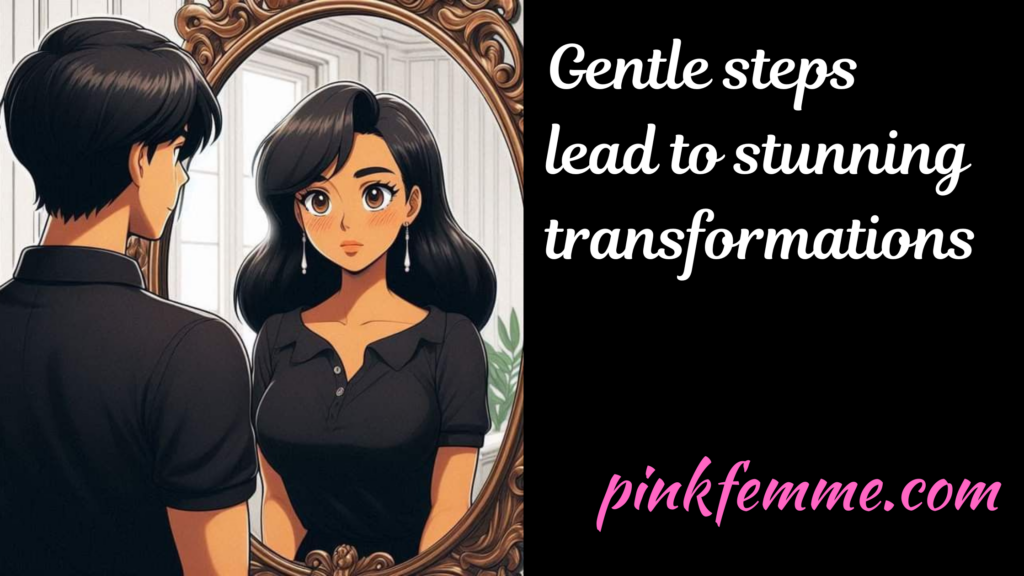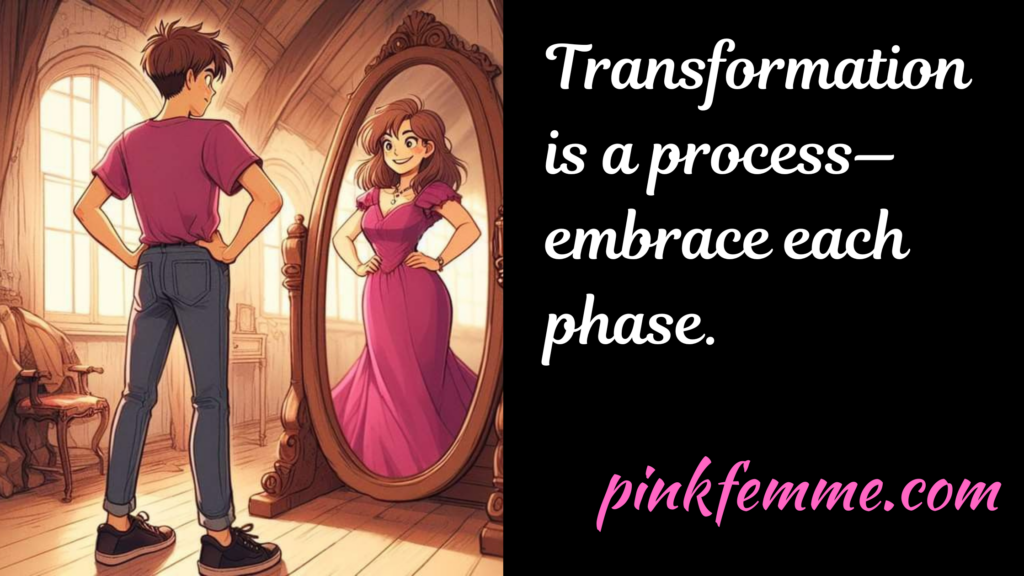
Navigating the world as a transgender woman is a journey filled with triumphs, challenges, and learning curves. While many dream of seamless integration into society, the quest to “pass” can often lead to heightened visibility rather than the desired blending in. This article explores the delicate balance between expressing femininity and finding your authentic style during transition.
Many trans women face heightened visibility by hyper-feminizing early in their transitions, often leading to misgendering or discomfort. Starting with an androgynous style and gradually embracing femininity can ease the journey, helping you grow in confidence and discover your unique, authentic expression.
Transitioning is an evolution of both identity and presentation. By starting with small, manageable changes and allowing your confidence to grow, you can navigate the process with grace and authenticity. Let’s explore how to avoid common pitfalls and embrace your journey to becoming your true self.
The Challenge of “Passing”
For many trans women, the concept of passing feels like a key to safety and social acceptance. However, hyper-feminizing too early in your journey often has the opposite effect. Instead of blending in, you might draw more attention to your gender transition. This isn’t to say that being visibly trans is wrong—it’s about aligning your external presentation with your internal identity in a way that feels right for you.
Understanding Passing and Its Complexities
Passing refers to being perceived as your true gender by society without raising questions. While it can offer a sense of safety and validation, it’s important to recognize that passing is not the ultimate measure of your identity or worth. For many, it’s a personal goal; for others, it’s a practical necessity to navigate societal norms.
Why Hyper-Feminization Often Backfires
When you hyper-feminize too early, the contrast between your presentation and your physicality may feel stark, especially if your body hasn’t yet adapted to hormone therapy. Overdone makeup, exaggerated clothing styles, or accessories that clash with your natural features can draw attention rather than help you blend in. Society often perceives these efforts as inauthentic, which can lead to discomfort, misgendering, or even negative reactions.
The Emotional Impact of Visibility
Heightened visibility can bring a mix of emotions. On one hand, it’s empowering to express your femininity; on the other, it can feel discouraging if the world doesn’t respond as you’d hoped. This tension underscores the importance of finding a presentation that feels authentic and sustainable for you.
Balancing Authenticity with Practicality
The key to navigating the challenge of passing is to balance your personal expression with practical considerations. Start by assessing what feels comfortable and authentic to you. Experiment with subtle changes, such as softer makeup or neutral clothing, before moving toward more pronounced feminine styles. Over time, you’ll develop a presentation that aligns with both your inner self and societal expectations.
Starting Your Transition: Embrace Androgyny
Transitioning is deeply personal, and no two journeys are the same. My advice? Begin with an androgynous look. By doing so, you’re removing the pressure to fully “pass” right away and allowing yourself time to grow into your feminine identity naturally.
Why Start with Androgyny?
Starting with an androgynous style provides a flexible, low-pressure way to express your gender identity while avoiding the pitfalls of hyper-feminization. It’s an approach that allows you to gradually ease into your true self, letting you refine your style and build confidence as your journey progresses.
Building an Androgynous Wardrobe
Begin by replacing overtly masculine clothing with neutral, versatile pieces. Think about items like fitted jeans, plain t-shirts, button-down shirts, and sweaters in muted tones. These garments work well for blending into any environment while subtly signaling your gender expression.
Consider adding accessories that feel more aligned with your femininity but don’t overwhelm your look. Small stud earrings, simple bracelets, or neutral-toned bags are excellent starting points.
Hair and Grooming: Small Changes, Big Impact
Your hairstyle can make a significant difference in your presentation. Opt for a cut that leans more gender-neutral while growing out your hair to the length you desire. Similarly, focus on skincare and grooming to enhance your appearance. Clear skin and well-maintained eyebrows, for example, can soften your features and give you a confidence boost.
The Confidence Boost of Androgyny
An androgynous look empowers you to step into the world as your authentic self without feeling overexposed. It’s about finding a balance between comfort and expression. This approach also helps you ease into navigating social interactions, which can be challenging at the start of your transition.
Evolving Your Style Over Time
As you grow more comfortable and confident, begin incorporating more feminine elements into your wardrobe. Start small with items like blouses, skirts, or heels for specific occasions. Over time, you’ll discover what works best for your body shape, personality, and lifestyle.
Embracing Your Unique Journey
Every trans woman’s journey is unique, and there’s no one-size-fits-all approach to transition. The androgynous starting point is not a rule but a guideline to help you navigate the early stages with confidence and ease. As you experiment and evolve, you’ll find the style and presentation that truly feel like you.
Avoiding the Hyper-Femme Trap
The Pressure to Overcompensate
Many trans women feel compelled to hyper-feminize as a way to assert their identity strongly. This approach often stems from internalized expectations or societal norms, where femininity is equated with exaggerated styles, heavy makeup, and overtly feminine clothing. While this may feel affirming in the short term, it can sometimes amplify visibility rather than reduce it.

Why Hyper-Femme Can Be Counterproductive
Hyper-feminization can sometimes clash with the physical and emotional realities of early transition. Overusing makeup or selecting clothing designed for different body types might draw more attention than intended. These choices can inadvertently signal a performative femininity rather than a natural expression of self.
Developing Your Feminine Archetype
Instead of leaning into hyper-feminine styles immediately, take time to explore what femininity means to you. Ask yourself questions like:
- What kind of woman do I see myself as?
- What styles resonate with my personality?
- What do I feel most comfortable wearing?
This reflection can guide you toward a personal style that aligns with your internal sense of self, creating a more harmonious external presentation.
Gradual Evolution Over Abrupt Change
Rather than adopting an entirely hyper-femme look from the start, consider integrating feminine elements slowly. Experiment with softer fabrics, pastel colors, or modest makeup. Over time, as your confidence grows and your body adapts to hormonal changes, you can introduce bolder styles that feel true to you.
The Emotional Toll of Hyper-Femme Expectations
Trying to conform to an extreme feminine standard can lead to feelings of inadequacy or disappointment, particularly if your appearance doesn’t match your expectations. Hyper-femme styles can also invite negative attention or misgendering, which can be emotionally taxing.
Embracing Authenticity in Femininity
Authenticity is key. If you naturally gravitate toward hyper-femme styles and they bring you joy, embrace them wholeheartedly. However, if you’re choosing these styles out of a sense of obligation or pressure, it’s worth reevaluating. Your journey is about expressing who you are, not meeting an arbitrary standard.
Celebrating Individual Style Choices
Ultimately, femininity is a spectrum, and your expression should reflect your unique identity. Whether you prefer subtle, understated looks or vibrant, bold styles, the most important thing is that you feel comfortable and confident. Taking the time to explore and refine your presentation will help you step into your true self with pride.
The Breast Forms Dilemma
The Appeal of Breast Forms
For many trans women, breast forms are a valuable tool during the early stages of transition. They provide an immediate sense of alignment with your gender identity, offering a more feminine silhouette that can boost confidence. Seeing your reflection with these enhancements can be a source of immense gender euphoria.
The Catch-22 of Breast Forms
Despite their benefits, breast forms can also trigger dysphoria. The reliance on an external aid to feel aligned with your gender identity may serve as a reminder that your natural body hasn’t yet fully transformed. This duality—gender euphoria from the appearance and dysphoria from the reality—can create an emotional push-and-pull.
Emotional Impact: One Step Forward, Two Steps Back?
Wearing breast forms can feel like progress, but removing them at the end of the day might evoke feelings of loss or inadequacy. This emotional rollercoaster underscores the importance of using them mindfully and considering your long-term goals.

Avoiding Unrealistic Expectations
Breast forms can also set expectations for breast size that may not align with what hormone therapy or natural development can achieve. While they offer an immediate visual change, it’s essential to honor the natural progression of your body. Hormones, combined with patience, can yield meaningful and lasting results over time.
Honoring Your Natural Growth
Allowing your body to transform naturally through hormone therapy fosters a deeper connection with your evolving femininity. Estrogen typically promotes breast tissue growth, and after six months, introducing progesterone under medical supervision can further enhance development. This process may take time, but it’s a journey worth embracing.
When Breast Forms Work for You
For some, breast forms remain a cherished part of their transition. If they bring you joy and confidence without triggering dysphoria, they can be a helpful tool. Transitioning is deeply personal, and what works for one person may not work for another. Use them in ways that affirm you while remaining mindful of their impact.
Building Confidence Without Enhancements
As you progress in your transition, focus on building confidence in your natural body. Developing your style, mastering makeup techniques, and embracing your unique femininity will allow you to feel aligned without reliance on external aids. Over time, this confidence will shine through, enhancing every aspect of your presentation.
Growing into Your Feminine Confidence
Transitioning into your authentic self is as much about inner transformation as it is about external presentation. Growing into your feminine confidence involves embracing the process, nurturing your evolving identity, and allowing time for self-discovery. It’s a journey that deserves patience, self-compassion, and celebration.
Allowing Time for Growth
Confidence doesn’t happen overnight, especially when transitioning. Think of your journey as a flower blooming. Just as a flower takes time to grow, so will your comfort in your feminine identity. Accept that some aspects of your appearance and style will take time to refine.
Learning Through Experimentation
Take your time to explore different looks, styles, and approaches. Whether it’s makeup, clothing, or how you carry yourself, experimentation is key. Make small changes to see what feels most comfortable. You’ll find that each discovery adds a layer of confidence to your identity.
Building Comfort in Social Interactions
Stepping out into the world as your authentic self can be daunting. Start small—visit spaces where you feel safe and affirmed. As you gain positive experiences and learn to navigate social interactions, your confidence will naturally grow.
Developing Your Unique Style
Your personal style is an extension of your identity. Rather than striving to mimic others, focus on what makes you feel empowered. Over time, your wardrobe will reflect your true self, and you’ll carry that confidence into every interaction.
Embracing Feedback and Support
Seek constructive feedback from trusted friends, allies, or online communities. Input from others can help refine your approach and boost your self-esteem. Similarly, surrounding yourself with supportive individuals provides encouragement on tough days.
Celebrating Every Milestone
Acknowledge and celebrate every step forward, no matter how small. From perfecting a makeup technique to finding an outfit that makes you feel radiant, these milestones are a testament to your progress and courage.
Blooming into Your Authentic Self: A Journey Worth Celebrating
The journey to discovering and expressing your true self is unique to every trans woman. It’s a path filled with lessons, triumphs, and the occasional setback. Starting with an androgynous presentation, avoiding the hyper-femme trap, and embracing gradual growth allows you to navigate this transition with grace and authenticity.
Each phase of this journey contributes to the person you’re becoming. Remember, the goal isn’t to meet societal expectations but to embrace what feels right for you. Growing into your feminine confidence is about aligning with your inner truth and allowing your outer presentation to reflect that.
Your story is one of resilience and transformation. By approaching your transition as a process of self-discovery, you empower yourself to step into your authentic self with pride and confidence. Celebrate every milestone, cherish your growth, and trust that you are exactly where you need to be.
If you are looking for more lifestyle-related posts here on Pink Femme, you can find them all here.
Why not expand your knowledge even further by reading another makeup/beauty article here on Pink Femme? You can find them either via the menu at the top of the page or by clicking this link that will take you to the list of all the beauty articles.
When it comes to my choices for makeup and beauty products, I only use L’Oréal Paris (Available on Amazon). I have really sensitive skin and never once have I had any negative reaction to any L’Oréal product.
If you enjoy reading romance stories, take a look at my author page on Amazon where you will find all the novels that I have published so far.
Keep up to date with all my latest femme news with the fabulous Pink Femme Newsletter. Each Monday you’ll receive an email from me that will include a chapter from the novel that I am currently writing. I will also alert you to interesting information from articles that have not yet been published on Pink Femme. The Pink Femme Newsletter is the only place to see chapters from the novels before they are published. Sign up today: PINK FEMME NEWSLETTER.
References
- American Psychological Association. (2023). Guidelines for psychological practice with transgender and gender nonconforming people.
- Bockting, W. O., Knudson, G., & Goldberg, J. M. (2006). Counseling and mental health care for transgender adults and loved ones. International Journal of Transgenderism, 9(3-4), 35-82.
- Coleman, E., Bockting, W., Botzer, M., et al. (2022). Standards of care for the health of transgender and gender diverse people, Version 8. International Journal of Transgender Health, 23(S1), S1-S259.
- Lev, A. I. (2004). Transgender emergence: Therapeutic guidelines for working with gender-variant people and their families. Haworth Clinical Practice Press.
- Grant, J. M., Mottet, L. A., Tanis, J., et al. (2011). Injustice at Every Turn: A Report of the National Transgender Discrimination Survey. National Center for Transgender Equality and the National LGBTQ Task Force.
- Budge, S. L., Adelson, J. L., & Howard, K. A. S. (2013). Anxiety and depression in transgender individuals: The roles of transition status, loss, social support, and coping. Journal of Consulting and Clinical Psychology, 81(3), 545-557.
- Ettner, R., Monstrey, S., & Eyler, A. E. (Eds.). (2007). Principles of transgender medicine and surgery. Haworth Press.
- Fraser, L. (2009). Depth psychotherapy with transgender people. In B. Wainwright (Ed.), Psychotherapy and Counseling with Transgender and Gender-Variant Clients (pp. 75-96). Routledge.
- James, S. E., Herman, J. L., Rankin, S., Keisling, M., Mottet, L., & Anafi, M. (2016). The Report of the 2015 U.S. Transgender Survey. National Center for Transgender Equality.
- World Professional Association for Transgender Health (WPATH). (2022). Standards of Care for the Health of Transgender and Gender Diverse People, Version 8.
